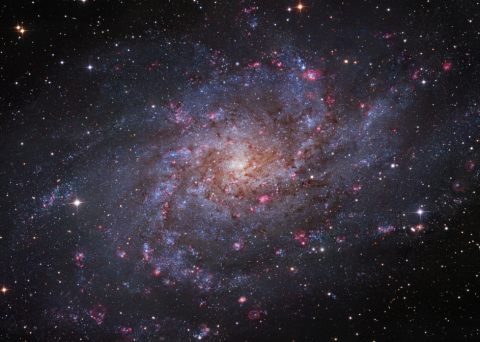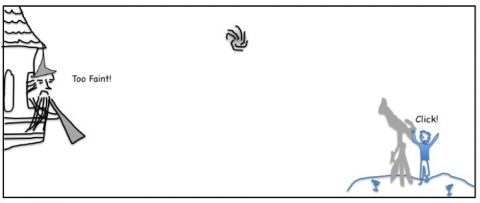International Year of Light and Light-based Technologies
Aglaé Kellerer
The International Year of Light and Light-based Technologies involves artists and scientists across a large range of domains. It certainly also involves astronomers and to honour this year, we might temporarily rename our group the Laboratory of Light Pathology. Astronomers analyze light in order to understand the formation, evolution and subsequent fate of celestial bodies. While though this sounds obvious today, it seemed inconceivable in the past. 180 years ago, the French philosopher Auguste Comte argued that we would never be able to determine the chemical or mineralogical structure of planets other than Earth since we couldn't obtain geological samples (Auguste Comte, “The Positive Philosophy”). Nowadays our improved understanding of light-matter interactions allows precise analyses of planetary, stellar and inter-stellar compositions.
One of the most extraordinary aspects of our research is the process of astronomical imaging itself. Consider a photon emitted by M33, the Triangulum Galaxy. If this is your favorite galaxy, you are quite right, because it certainly looks stunning (see Fig.1). Consider a photon emitted by a star in this galaxy 3 million years before it reaches your telescope. Moments before it is recorded by your detector, it is located on an immense sphere centered around M33, a sphere with a radius of 3 million light years.

Fig.1: M33, the Triangulum Galaxy. Image Credit & Copyright: Robert Gendler, Subaru Telescope (NAOJ). Image data: Subaru Telescope, Robert Gendler, Brigham Young University Obs., Johannes Schedler. http://apod.nasa.gov/apod/ap121220.html
Now imagine a group of astronomers on Htrae, a small imaginary planet that orbits a system of two stars, on the other side of M33, 6 million light years from Earth. M33 has been a longtime favorite of Notwen, the president of Htrae's Physical Society. At this moment, a new instrument is being tested, an overwhelmingly large visor (OWL) - it has a diameter of 0.1m, very large indeed for such a small planet. Notwen has decided to aim it towards M33. From that point, the race is on. Who will collect the photon, you or Notwen?
Both your telescope and Notwen´s OWL have an - admittedly tiny - chance to record the photon. Both are 3 million light years away from the source of the photon, with your 0.2m diameter instrument the chance is 4 times larger. But if either your detector clicks or OWL does, the other detector´s chance to observe the photon vanishes immediately. Notwen is six million lights years away, but your detection of the photon has an instantaneous effect on its instrument, it wipes out its chance to register the photon.
How can we understand this seeming disregard of photons for space and time?
Newton was famously bothered by Gravity's action at a distance: "That gravity should be innate, inherent and essential to matter so that one body may act upon another at a distance through a vacuum without the mediation of any thing else by and through which their action or force may be conveyed from one to another is to me so great an absurdity that I believe no man who has in philosophical matters any competent faculty of thinking can ever fall into it." (http://www.newtonproject.sussex.ac.uk/view/texts/normalized/THEM00258) However, he also explained that "it is enough, that gravity does really exist, and act according to laws which we have explained, and abundantly serves to account for all the motions of the celestial bodies, and of our sea." (http://www.newtonproject.sussex.ac.uk/view/extract/normalized/NATP00056/start=par3&end=par4%29)
Today we are in a similar situation with elementary particles. Quantum electrodynamics is both bewildering and successful. We use it to understand astronomical observations and to improve the performance of telescopes, and we wonder about its profound mysteries. Photons do not experience space and time as we do on our scales. Do the concepts of space and time merely emerge from large networks of particles?
Telescopes allow us to explore the frontiers of the Universe, to investigate what it is made of and how it evolved. Since the telescope was first invented, our knowledge of the laws of optics have been revolutionized, notably with the advent of Quantum Electrodynamics. Can we use novel quantum optical processes to improve the performance of our telescopes and, thereby, improve our knowledge of the Universe?

Fig.2: Notwen, the president of Htrae's Physical Society, tests the new overwhelmingly large visor (OWL) on M33. You observe the same target from your backyard.

Fig. 3: Notwen is six million lights years away, but your detection of the photon has an instantaneous effect on him: it wipes out his chance to register the photon.
Gottesman et al. (http://journals.aps.org/prl/abstract/10.1103/PhysRevLett.109.070503) and Riaud (http://link.springer.com/article/10.1140%2Fepjd%2Fe2011-20008-5) have independently proposed to use photon entanglement to increase the distance between the telescopes of an interferometer. Cotler and Wilczek (http://arxiv.org/abs/1502.02477) just recently suggested to substantially widen the possibilities of interferometry by using entanglement. I suggested a scheme to overcome the diffraction limit at the expense of sensitivity by use of quantum non-destructive measurements (QND) (http://www.aanda.org/articles/aa/abs/2014/01/aa22665-13/aa22665-13.html).
QND detections are a radical breakthrough of modern optics: When photons arrive on a detector - e.g. the retina or a CCD chip - they interact with atoms, the energy of the photon is transmitted to the atom and the photon is thereby destroyed. In a non-destructive measurement, the photon is detected, but not destroyed. This is an active field of research, notably in the context of quantum computers, where photons are to be used as information carriers (flying qu-bits) between quantum gates (http://www.sciencemag.org/content/342/6164/1349 and http://www.nature.com/nature/journal/v508/n7495/full/nature13177.html).
As astronomers, we have every reason to celebrate the International Year of Light. Most of our knowledge about the Universe comes from light. New technologies help us extract the maximum information out of every collected photon. This will allow us to make discoveries that we do not yet imagine.

